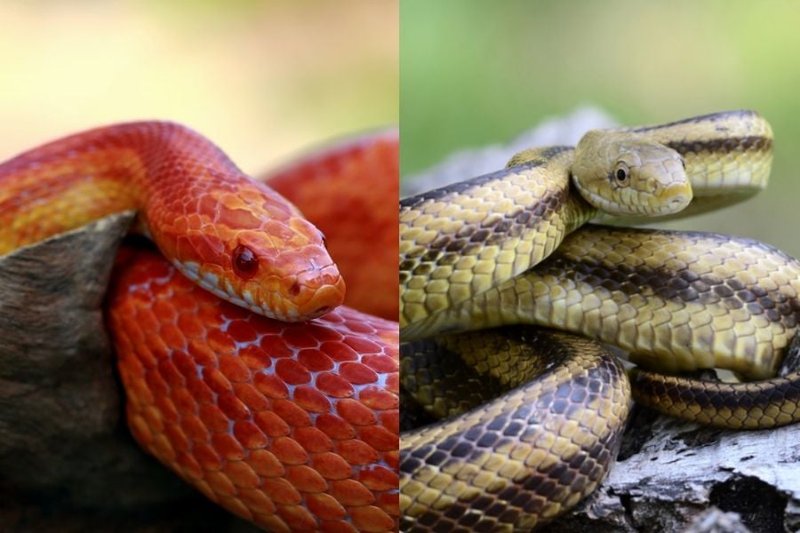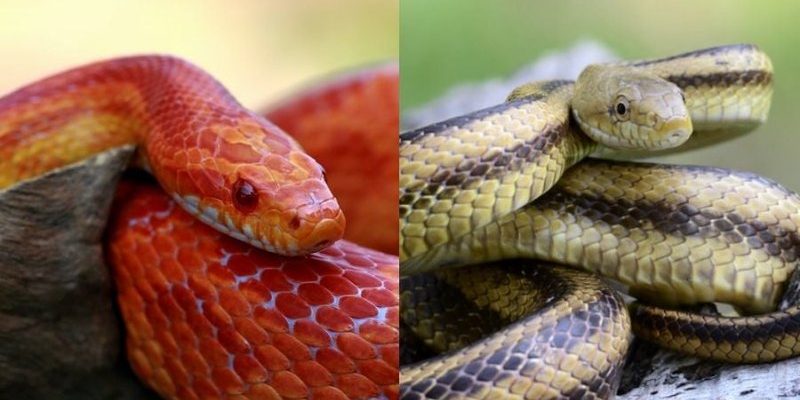
Imagine being a corn snake, slithering through fields and forests, your beautiful, patterned skin blending in with the environment like a well-camouflaged secret agent. Every twist and turn you make is strategically planned, ensuring you evade predators and find your next meal. It’s a fascinating world out there, filled with challenges, and the corn snake is built to handle them. Let’s dive into the remarkable adaptations that equip these reptiles for survival.
Camouflage: Blending In with the Environment
One of the corn snake’s most impressive adaptations is its camouflage. Think of it like wearing a clever outfit that helps you remain unnoticed in a crowd. Their scales bear a mix of orange, brown, and black markings, allowing them to blend into the leaf litter and grasses of their natural habitat. This natural disguise is essential for both evading predators and sneaking up on unsuspecting prey, like rodents and small birds.
Here’s the thing: a well-camouflaged corn snake can lie still for long periods, waiting for the perfect moment to strike. Imagine being able to freeze in place while your dinner walks right by you—that’s the beauty of their rich coloration. It’s not just about looking pretty; it’s a life-or-death tactic.
In return, this adaptation also comes with a bonus: it helps them stay hidden from human eyes. If you’re out hiking and spot a corn snake, it may take a moment for your brain to register what you’re seeing. With their stunning patterns, they can often go unnoticed, which is both fascinating and a bit of a reminder of how stealthily they navigate their world.
Body Structure: Built for Efficiency
Next up is the body structure of the corn snake. Compared to some of its bulkier relatives, the corn snake boasts a slender, elongated body. This design isn’t just for show; it allows them to move swiftly and efficiently through diverse terrains, from trees to underbrush. Imagine a gymnast, gracefully flipping and twisting through air—that’s how a corn snake moves with ease across its environment.
The corn snake’s flexible spine helps it navigate through tight spaces and climb trees in search of food or safety. This adaptability really shines when you consider their hunting strategy. With the ability to coil and strike quickly, they can capture prey in a quick grasp, ensuring they get the nutrition they need without expending too much energy.
Additionally, their ventral scales—those shiny, smooth scales on their belly—act like a ladder, helping them grip surfaces and climb with agility. It’s like having a built-in climbing gear that makes them the acrobats of the snake world. This structural design equips them to thrive not only on the ground but also up in the trees, expanding their hunting grounds and survival options.
Behavioral Adaptations: Master of Survival
Corn snakes have also developed some interesting behavioral adaptations that make them survivors in the wild. For one, they often display a tendency to be crepuscular, meaning they are most active during dawn and dusk. This timing helps them avoid the hottest parts of the day when predators might be on the prowl. Imagine timing your outings to avoid rush hour traffic—that’s the insightful survival strategy of the corn snake.
When faced with danger, these snakes have a fascinating way of handling threats. Instead of taking off in a panic, a corn snake might freeze in place or mimic the behavior of a rattlesnake by shaking its tail in dry leaves. This deceptive tactic can confuse predators, giving the corn snake a chance to escape unnoticed. It’s like an actor playing a role, fooling their audience to create an exit strategy.
Moreover, their social behavior is equally remarkable. Corn snakes are known to live in loose aggregations, especially during the winter months when they seek out shared spaces for warmth. This behavior not only helps them stay cozy during cold snaps but also offers some safety in numbers against potential threats. Sharing space isn’t just a way of avoiding the cold—it’s also a smart survival strategy.
Dietary Adaptations: The Hunter’s Skillset
Let’s talk about what keeps the corn snake alive—its diet. Corn snakes are known as constrictors, meaning they use their powerful bodies to wrap around and subdue their prey. Unlike some snakes that swallow prey whole, corn snakes typically eat rodents—like mice or rats—by squeezing them to suffocate them first. This method is highly effective and allows the snake to tackle prey that might seem a bit too large otherwise.
What’s interesting is how adaptable their diet can be. While they primarily hunt rodents, corn snakes will also eat birds and their eggs when the opportunity arises. This flexibility in diet means they can thrive in different habitats, adjusting their hunting habits based on what food sources are available. It’s like having a versatile diet plan that allows you to thrive, no matter the season or environment.
Another crucial part of their hunting strategy is their keen sense of smell. Using their forked tongues, corn snakes can “taste” the air, picking up chemical cues that lead them to potential meals. Think of it as having a built-in GPS for finding food—one that can navigate even when the lights go out.
Reproductive Adaptations: The Next Generation
When it comes to ensuring their legacy, corn snakes have some smart reproductive adaptations. They are oviparous, which means they lay eggs rather than giving live birth. Most adult females will seek out warm, humid environments to lay their eggs, ensuring that the hatchlings have the best possible conditions for survival. It’s like finding the perfect neighborhood to raise a family.
After laying eggs, female corn snakes won’t guard them, but they’ll often choose nesting sites where they are less likely to be disturbed. Some even wiggle into the ground to keep the eggs insulated. This choice is essential, as it provides optimal conditions for incubation, allowing the eggs to develop properly.
Once the hatchlings emerge, they’re typically independent from day one. While many animals require parental care, corn snake babies—often called hatchlings—are ready to fend for themselves, immediately seeking out food and shelter. This strategy increases their chances of survival in the wild, as they can quickly disperse and adapt to their new environments. It’s a bold move, but it pays off!
Conservation Status and Adaptation to Challenges
Finally, let’s discuss the conservation status of corn snakes and how they adapt to the challenges humans bring to their habitats. While they are generally not listed as endangered, habitat destruction and road mortality remain significant threats. Corn snakes are known for being resilient in adapting to changes in their environments, but this can only go so far.
In areas where their natural habitats are disrupted, corn snakes may seek out urban environments or agricultural fields. They often take advantage of rodent populations that thrive in human-dominated spaces, showing their ability to adapt to changing food sources. However, this adaptation also comes with risks, as they face dangers like traffic and pesticide exposure.
It’s essential for us to protect these wonderful creatures by preserving their natural habitats and reducing our impact on their environments. By understanding their needs and behaviors, we can contribute to their survival and ensure that future generations can appreciate the beauty and adaptability of corn snakes.
In conclusion, corn snakes are a perfect example of nature’s ingenuity. From their stunning camouflage and efficient body structure to their clever hunting strategies and reproductive methods, each adaptation helps them navigate life’s challenges. By appreciating their unique traits and understanding their struggles, we can work together to ensure they thrive for years to come.

